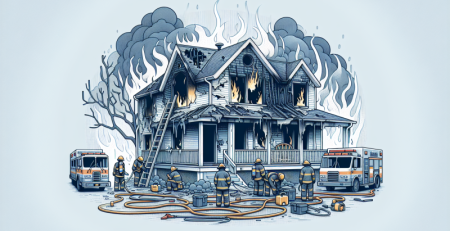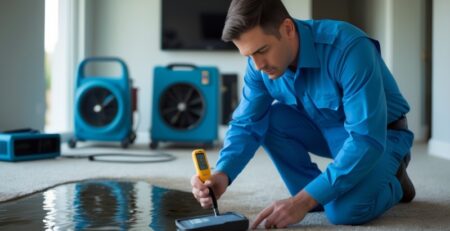How to Create a Fire-Resistant Home Environment
Creating a fire-resistant home environment is essential for safeguarding your property and loved ones. Have you ever considered the steps you can take to minimize fire risks in your home? With the right strategies and materials, you can significantly enhance your home’s resilience against fire hazards.
To achieve a fire-resistant home, focus on using non-combustible materials, maintaining defensible space around your property, and implementing fire safety practices. Experts recommend installing fire-resistant siding, using tempered glass windows, and ensuring your roof is made of fire-rated materials. Additionally, regular maintenance, such as clearing debris from gutters and maintaining landscaping, plays a crucial role in fire prevention. Pair your structural upgrades with everyday fire prevention tips for maximum safety.
But these are just a few starting points in your journey to a safer home. In this article, we will explore comprehensive strategies and expert insights on creating a fire-resistant environment. Join us as we delve into practical tips and proven methods to protect your home from fire threats, ensuring peace of mind for you and your family.
Understanding Fire Resistance
Fire resistance refers to a material’s ability to withstand fire and prevent its spread. This quality is crucial for home safety, as it protects lives and property. Understanding the science behind fire resistance involves recognizing how certain materials and construction techniques can minimize fire risks. For instance, using non-combustible materials like brick or concrete can significantly enhance a home’s fire resistance. Additionally, employing advanced construction methods, such as fire-rated walls and ceilings, can further safeguard your living space.
It’s essential to differentiate between fire-resistant and fireproof materials. Fire-resistant materials can endure high temperatures for a limited time, while fireproof materials are designed to withstand fire indefinitely. However, no material is entirely fireproof. Therefore, homeowners should prioritize fire-resistant options when designing or renovating their homes. By doing so, they can create a safer environment that minimizes the risk of fire damage. Investing in fire-resistant materials and techniques is a proactive step toward ensuring long-term safety and security in your home.
Assessing Your Home’s Vulnerability
To effectively assess your home’s vulnerability to fire, start with a comprehensive checklist. First, examine your roof for flammable materials. Consider replacing wooden shingles with fire-resistant options. Next, inspect your walls; ensure they are made of non-combustible materials. Pay attention to any gaps or cracks that could allow embers to enter.
Additionally, evaluate your landscaping. Keep shrubs and trees at least 30 feet away from your home. Trim overhanging branches to prevent them from igniting your roof. Furthermore, consider the placement of firewood and propane tanks; store them away from your house.
Statistics reveal that nearly 50% of home fire incidents occur due to structural vulnerabilities. In fact, homes with wooden siding are at a higher risk. Therefore, taking proactive measures is crucial. Regularly assess your property and make necessary adjustments. For more information on enhancing your home’s safety, visit our about page or explore our fire cleanup services. Don’t wait until it’s too late; start your assessment today.
Fire-Resistant Building Materials
When constructing a fire-resistant home, selecting the right materials is crucial. Concrete and brick are excellent choices due to their natural resistance to flames. Fire-rated glass also offers protection while allowing natural light into your space. These materials can significantly reduce the risk of fire spreading.
For roofing, opt for materials like metal or tile, which withstand high temperatures. Siding made from fiber cement or stucco provides additional fire resistance. Insulation is another critical area; consider using non-combustible options like mineral wool or fiberglass. Each area of your home requires specific materials to maximize safety.
Using fire-resistant materials during new construction offers distinct advantages. It ensures that your home is built to withstand potential fire hazards from the start. In contrast, retrofitting existing homes can be more challenging and costly. However, it can still enhance safety and potentially lower insurance premiums. Ultimately, investing in fire-resistant materials is a proactive step toward protecting your home. For more information on enhancing your home’s safety, visit our about page or explore our services.
Landscaping for Fire Safety
Creating a defensible space around your home is crucial for fire safety. Start by clearing a zone of at least 30 feet from your house. This area should be free of flammable materials, such as dry leaves and dead plants. Next, consider using fire-resistant plants. Species like lavender, sage, and certain succulents can withstand heat and flames. Place these plants strategically, ensuring they are spaced out to prevent fire from spreading.
Additionally, maintaining your vegetation is vital. Regularly trim shrubs and trees, keeping branches at least 10 feet away from your roof. This practice reduces the risk of fire catching onto your home. Furthermore, clear debris from gutters and patios to minimize fire hazards.
For more detailed strategies on enhancing your home’s safety, explore our services. You can also learn about effective residential design that incorporates fire-resistant landscaping. Prioritizing these elements will significantly improve your home’s resilience against wildfires.
Fire-Resistant Home Design Features
When designing a fire-resistant home, certain architectural features play a crucial role. Overhangs and eaves can effectively shield walls from radiant heat. Additionally, decks should be constructed using non-combustible materials to reduce fire risk. These elements not only enhance aesthetics but also provide practical protection.
Firebreaks and barriers are essential in home design. They create a defensible space that slows the spread of flames. Strategically placed firebreaks can significantly reduce the risk of fire reaching your home. Incorporating these features into your landscape design is vital for safety.
Moreover, outdoor spaces should be designed with fire safety in mind. Use gravel or stone instead of mulch around your home to minimize flammable materials. Planting fire-resistant vegetation can also help create a buffer zone. Regular maintenance, such as clearing debris, is necessary to maintain this safety. For more information on enhancing your home’s safety, visit our residential design page. If you need assistance with fire cleanup, check our fire cleanup services. For further inquiries, feel free to contact us.
Installing Fire Safety Systems
Installing fire safety systems is crucial for protecting your home. Start with smoke detectors. Place them in every bedroom and hallway. Ensure they are interconnected for maximum safety. Next, consider fire alarms. These systems alert you and your family to danger. Choose a model that suits your home’s layout. Additionally, sprinkler systems can significantly reduce fire damage. Install them in key areas, such as kitchens and garages.
Regular maintenance is essential. Test smoke detectors monthly. Replace batteries at least once a year. For fire alarms, follow the manufacturer’s guidelines for testing and replacement. Sprinkler systems should be inspected annually by a professional. This ensures they function correctly when needed.
Moreover, updating your fire safety equipment is vital. Technology evolves, and newer models often offer better protection. Regularly review your systems and replace outdated units. By prioritizing these steps, you enhance your home’s safety. For more information on fire safety, visit our fire cleanup page. Additionally, check out our about section for more insights.
Creating an Emergency Plan
An effective fire escape plan is crucial for every family member. It ensures everyone knows how to react during a fire emergency. Start by identifying all possible exits in your home. Next, create a clear route to safety from each room. Practice this route regularly, so everyone feels confident and prepared.
Designate a meeting place outside your home. This location should be a safe distance away, allowing you to account for everyone. Additionally, establish a communication plan. Ensure each family member knows how to reach one another after escaping. This step is vital, especially if you have children or elderly relatives.
Incorporate regular drills into your routine. These drills reinforce the escape plan and help identify any areas for improvement. Remember, a well-practiced plan can save lives. For more tips on safeguarding your home, visit our fire cleanup page. Additionally, explore our about section for more insights on home safety.
Regular Maintenance and Inspections
Regular maintenance is crucial for ensuring fire safety in your home. Start with a seasonal checklist. In spring, inspect smoke detectors and replace batteries. During summer, clear gutters and check for overhanging branches. In fall, examine your heating systems and clean chimneys. Finally, winter is the perfect time to review fire extinguishers and ensure they are accessible.
Professional inspections play a vital role in maintaining fire safety systems. Experts can identify hidden hazards that homeowners might overlook. They assess the integrity of fire alarms, sprinkler systems, and structural elements. Regular professional evaluations can prevent potential disasters.
Homeowners can also conduct their own inspections. Begin by checking smoke detectors monthly. Test each unit and replace any that are malfunctioning. Next, examine electrical cords for fraying or damage. Ensure that escape routes are clear and accessible. Additionally, familiarize yourself with your local fire codes and regulations. For more information on fire safety measures, visit our fire cleanup page. If you need assistance, don’t hesitate to reach out through our contact page. Regular vigilance can significantly enhance your home’s fire safety.
Community Resources and Support
Local fire departments often offer educational programs focused on fire safety. These programs teach residents about fire prevention and emergency response. Additionally, community organizations frequently host workshops and events to raise awareness. Engaging with these resources can significantly enhance your understanding of fire safety.
The community plays a vital role in fire prevention. When neighbors collaborate, they create a safer environment for everyone. Sharing knowledge and resources fosters a culture of vigilance. Moreover, participating in local initiatives strengthens community bonds.
Getting involved is straightforward. Attend meetings hosted by your local fire department or community center. Volunteer for fire safety events or programs. You can also support local fire cleanup efforts by joining initiatives that focus on recovery and prevention. For more information on how to contribute, visit this page. Explore various services that promote fire safety in your area. Together, we can build a resilient community prepared for emergencies.
Frequently Asked Questions
When considering fire safety in your home, understanding fire-resistant materials is crucial. Opt for materials like brick, stucco, and concrete, which offer superior protection. Additionally, assessing your home for fire risks involves inspecting both the interior and exterior. Look for flammable materials and ensure proper spacing between plants and structures.
Landscaping practices play a significant role in reducing fire risk. Create defensible space by maintaining a buffer zone with non-flammable plants. Regularly testing your smoke detectors is essential; do it at least once a month to ensure they function properly.
Your fire emergency plan should include escape routes, meeting points, and emergency contacts. Familiarize yourself with local building codes that may mandate fire-resistant materials. If your home lacks these features, consider retrofitting it to enhance fire resistance.
Insurance is another critical aspect of fire safety. It can provide financial support in case of a disaster. Educating your family about fire safety ensures everyone knows what to do in an emergency. Lastly, be vigilant for signs that your home may be at risk for fire, such as dry vegetation or outdated electrical systems. For more information, visit our about page or explore our services.








